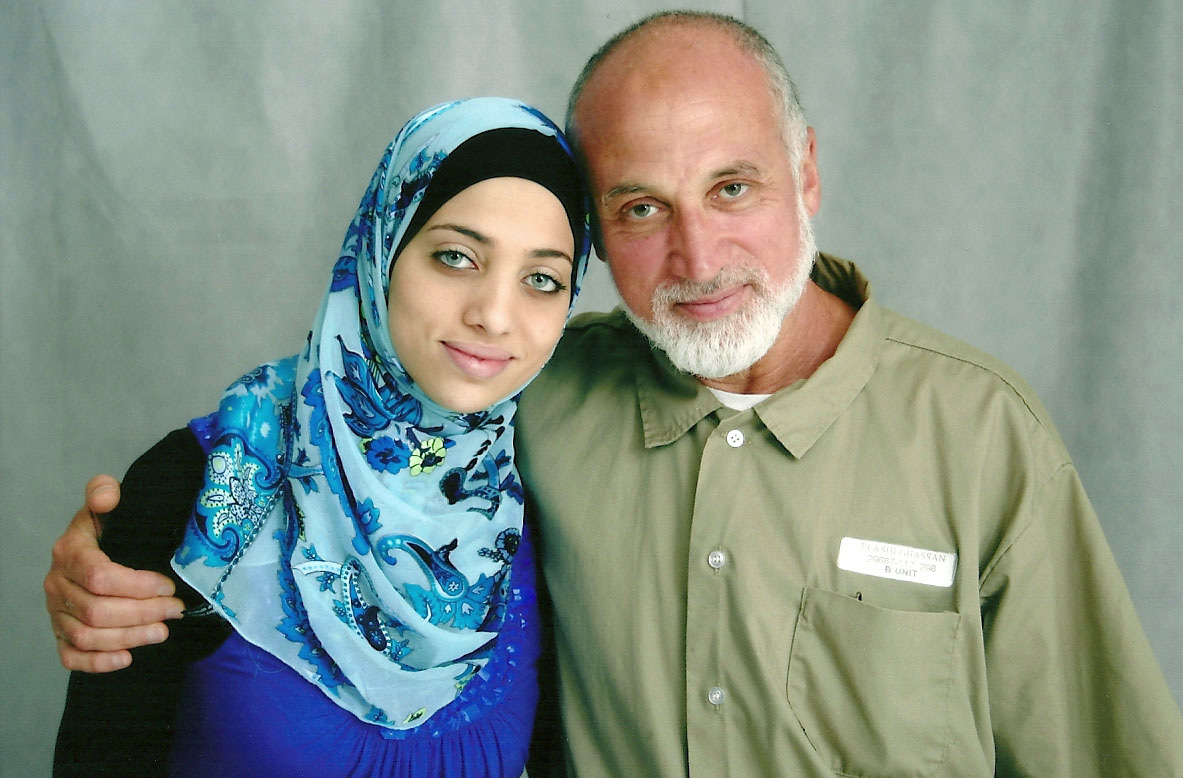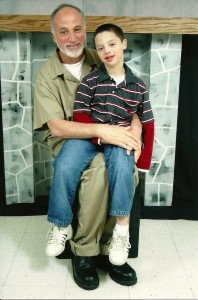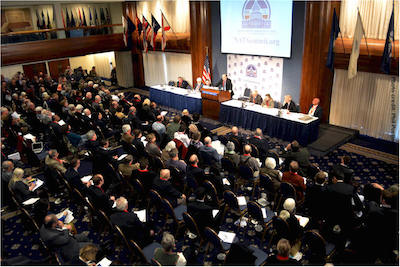Why is US holding Palestinian charity workers in “little Gitmos”?
Jul 24 2014 / 4:47 pm
By Charlotte Silver.
Electronic Intifada – Noor Elashi has not been able to hug her father for more than five years. Each time she visits him at United States Penitentiary in Marion, Illinois, they must communicate through a wall of Plexiglass. “It is unnecessarily cruel,” she told The Electronic Intifada.
Her father, Ghassan Elashi, is one of the Holy Land Five. He and four other US citizens have been prosecuted for their work with the Holy Land Foundation, a charity shut down by executive order in 2001. The case against them rested on a claim that the groups in

Ghassan Elashi and his son Omar in a photo taken in prison. (Courtesy of the Elashi family)
the occupied West Bank and Gaza Strip financed by the Holy Land Foundation were affiliated to Hamas. The claim was spurious: the State Department aid agency USAID funded some of the same groups.
Ghassan Elashi is paying a high price for his solidarity with fellow Palestinians. For the past five years, he has been in Marion’s Communication Management Unit (CMU).
Visiting Ghassan is an ordeal. To see him last May, Noor and her younger sister had to travel almost 1,000 miles from their home in New York City. The closest airport to Marion is in St. Louis, Missouri. At night, with no traffic, it is a two-and-a-half hour drive from the airport to the prison.
Ghassan had previously been held in Texas, where the entire Elashi family used to live (and some of them, including Noor’s mother, still do). At that time, Noor was able to see him every weekend. Now she can only do so once or twice a year.
The CMU at Marion was opened by the Federal Bureau of Prisons in 2008. It is one of two such units in the country (the other is in Terre Haute, Indiana). These units are often called “little Gitmos” because they bear similarities to Guantanamo Bay.
Prisoners are held in solitary confinement. The legality of the incarceration regime is questionable — the Center for Constitutional Rights has dubbed CMUs “experimental” as they are not subject to clear guidelines; instead the Bureau of Prisons has simply made up the rules as it goes along. And most of the inmates who have been held in the CMUs — more than 100 out of 178 men — are Muslim.
Blanket of surveillance
CMUs envelop their inmates with a blanket of surveillance, within the prison walls as well as on their communication with friends and family, making contact and visits not only infrequent but under conditions that severely limit personal interaction. Inmates at a CMU are allowed two 15-minute phone calls a week and a total of eight hours of non-contact visits a month. Other federal prisons allot inmates 300 minutes of telephone calls and 49 hours of contact visits.
“Yes, there’s an injustice in imprisoning him and the other men in the first place, but there is a greater injustice in limiting their communication with their family,” Noor Elashi said.
In May 2009, four of the Holy Land Five were transferred to CMUs. (The fifth, Abdulrahman Odeh, was brought to another prison in southern California.) Two of the five, Shukri Abu Baker and Mohammed El-Mezain, were held at the CMU in Terre Haute but have subsequently been moved to a different unit of that prison.
It is significant that a CMU was established at Marion. In 1963, United States Penitentiary Marion replaced San Francisco’s notorious Alcatraz as the harshest incarceration facility in the nation — the so-called “end of the line” prison. USP Marion held those men in the US penal system deemed “difficult to control,” placing them in solitary confinement and forcing them to undergo a new kind of “behavior modification” therapy.
Eventually an entire wing of the prison, called the control unit, would be dedicated to this type of “rehabilitative” incarceration. In 1983 a couple of inmates killed two guards in the control unit, precipitating a brutal crackdown which would lead, ultimately, to the entire prison being run in the same manner as the control unit — with 23-hour lockdown and restrictions of visits and other privileges — for the next 23 years. It would be the prototype for today’s so-called Supermax prisons.
Denial of rights
A district court in Washington, DC is considering the final arguments for summary judgment in a four-year-old case brought by the Center for Constitutional Rights against CMUs. In the case, the CCR argues that the government violates CMU prisoners’ rights under the US constitution, including the rights to due process in legal proceedings and the prohibition on cruel and unusual punishments.
The CCR filed for the summary judgment in late April after obtaining documents demonstrating there was no due process in determining who is placed in a CMU.
The CCR’s case was originally filed on behalf of five CMU prisoners and two of their wivess, but a ruling in their favor would have broader impact. A CCR lawyer, Rachel Meeropol, told The Electronic Intifada that the the center is trying to show that this type of detention is “unconstitutional.”
The CCR’s work has already had some results. On the eve of CCR’s lawsuit in March 2010, the Bureau of Prisons moved a man from a CMU for the first time since these units had been opened. Some other prisoners have similarly been moved from CMUs since then.
Singling out Islam
A 2006 report issued by the Department of Justice’s Office of Inspector General planted the first seed for the creation of the CMUs. The report determined that existing prison facilities and guards were not equipped to recognize or prevent “radicalization” of inmates, or inmates with “extreme ideology.” (The only “ideology” specifically referred to in the report was Islam.) It recommended that “The FBI should continue to develop and reinforce procedures for interacting with the BOP [Bureau of Prisons] regarding international terrorist inmates.”
Publicly, the Bureau of Prisons responded to the report with assurances that it had established a counterterrorism Unit (CTU) and a system of liaison between the prisons and the FBI to monitor and report any attempts to “radicalize” among the prison populations.
But privately something else was taking place. Three months after the Department of Justice report was published — in December 2006 — the Bureau of Prisons transferred fifteen men to the CMU at Terre Haute, Indiana, where the unit had been carved out of the prison’s former death row.
Erosion of civil liberties
The concept of of “radicalization” among Muslims has fostered a dangerous, terrifying erosion of Muslims’ civil liberties in America since the 11 September 2001 attacks, and has been used to justify a proliferation of preemptive prosecution.
The theory of “radicalization” places all Muslims on a path that could lead toward terrorist activity. Seeing all Muslims as potential terrorists has warranted the construction of a massive architecture within the criminal justice system that enables the FBI to entrap and prosecute hundreds of potential “terrorists” before a crime has been planned.
A report published by Project Salam, an organization dedicated to monitoring terrorism prosecutions and convictions, finds that over 72 percent of “terrorist” convictions were prosecuted under the dubious legal theory of preemptive prosecution.
“This means that these men are basically not dangerous to the American public. They should never have been put in there in the first place,” Steve Downs, attorney and founder of Project Salam, told The Electronic Intifada.
Analyzing the Department of Justice’s 2010 list of 399 convicted “terrorists,” the report asserts that this kind of preemptive prosecution is a weapon in the government’s arsenal for the domestic “war on terror.”
Downs argued, however, that there is no “war” — just a lot of trumped up prosecutions that “help the government give the impression that there is a terrorist army out there.”
“CMUs are important because it pretends that these people are very dangerous — the ‘worst of the worst’ — like at Guantanamo. But, remember, 80 percent of those men ended up being innocent,” he said.
Since the Supreme Court rejected a review of the Holy Land Five, Texas attorney Gary Udashen has been representing the men. They are now pursuing an application for a writ of habeas corpus, hoping to nullify the convictions and sentences.
Noor Elashi is hopeful that the Center for Constitutional Rights case could help move her father to a prison that is closer to her family, “but of course our ultimate hope is for him to be exonerated.”
—–
Charlotte Silver is a journalist based in San Francisco. Follow her on Twitter:@CharESilver.

